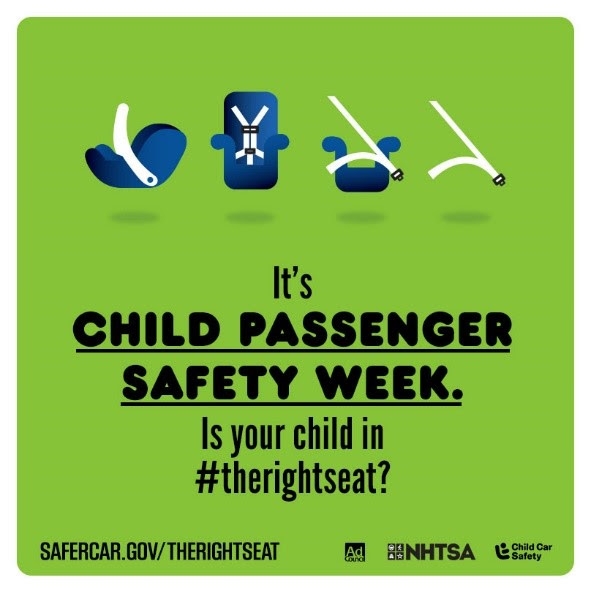Georgia's Child Passenger Safety Laws...What You Need To Know
For reference, the text of Georgia's child passenger safety seat laws can be found at O.C.G.A. 40-8-76. All children under the age of eight are required to be properly restrained in an approppriate child passenger safety seat or booster seat.
Focus on SELECTION
What: Making sure the car seat, booster seat, or seat belt is in good condition (has not been in a crash, is not expired or recalled, no labels missing) and appropriate for the child’s age, height, weight, and developmental level.
Why: Car seats and booster seats are the basic protection systems for passengers who are too small to get the full safety benefits from adult seat belts. The goal of car seats is to provide small children with the same protection, or better, that adults obtain from seat belts and other safety equipment built into a vehicle. They are designed to keep children within the vehicle and close to their original seating position, to prevent contact with harmful interior surfaces or other occupants, and to provide “ride-down” by gradually decelerating the child as the vehicle deforms and absorbs energy from crash forces. For this to work properly, the right seat must be selected for the child’s height, weight, and developmental levels.
Focus on DIRECTION
What: Facing the car seat in the correct direction for the age, height, weight, and developmental level of the child.
Why: Many children are advanced to the next seat stage before they are truly ready, which puts them at greater risk for injury in a crash. NHTSA suggests that children should ride rear-facing to the upper limits of their seats, and convertible seats with higher rear-facing weight and height limits allow many children to ride rear-facing well past the age of 2. Children are also being moved prematurely from harnessed car seats into booster seats, as well as from booster seats into adult seat belts, which puts them at greater risk for injury if the seat belt does not fit them correctly.
Focus on LOCATION
What: Placing the car seat or booster seat in an appropriate location in the vehicle.
Why: For all children under the age of 13, the back seat is the safest place for them to ride. They are better protected from head-on collisions, which constitute about 60 percent of all crashes. In addition, they are not at risk for being injured by the passenger air bag, which is designed for adult protection in conjunction with a seat belt. Familiarize yourself with the location of the air bags in your vehicle, with the help of your vehicle owner’s manual. A rear-facing car seat should NEVER be placed in front of an active air bag. When considering the best location for your child’s car seat, you should also consider the needs of other passengers who ride in the vehicle and the seating position that will provide an optimal installation for your child’s car seat. The middle seat in the back is often referred to as the ‘best’ seat for car seats because of the protection from side impact crashes, but any back seat position is a preferred location to install car seats. Also consider the needs of your family; for example, if you often park on a busy street, place your child’s car seat on the curb
side as opposed to the street side for optimal protection for you and your child when entering and exiting the vehicle.
Focus on INSTALLATION
What: Installing the car seat or booster seat in the vehicle correctly.
Why: It is estimated that 46 percent of car seats on America’s roads are installed incorrectly (NCRUSS, 2015). A car seat that is incorrectly installed will not provide optimal protection in a crash situation, and may put your child’s safety at risk. While great strides have been made in reducing child fatalities and injuries since the 1970s, over half of children killed in crashes are either improperly restrained or completely unrestrained (FARS, 2015). Car seats can be installed with either the seat belt or the lower anchors, and forward-facing seats should always utilize the tether. Seat belts in vehicles made after model year 1996 will have a locking mechanism, which enables the seat belt to be locked to install car seats. This is most often achieved by a
locking latchplate or switching the retractor into locking mode in order to lock the seat belt. Lower anchors are standard in vehicles manufactured after 2002, and are generally U-shaped metal anchors that are located in the bight (crack) of the vehicle seat. Current car seats come equipped with lower anchor webbing and
attachments, which when threaded through the correct belt path and securely fastened onto the anchors, create a secure installation for that car seat. While the systems are different, they are equally safe, and it’s recommended to use the seat belt or lower anchors – but NOT both. Most car seats have not been tested with both systems used together, so please consult both the vehicle owner’s manual and car seat instructions for help. Tether non-use in forward-facing car seat installation is one of the most common installation errors, yet correct use can significantly decrease the risk of head injuries in a crash.
Focus on HARNESSING
What: Securing the child properly in the car seat, booster seat, or seat belt.
Why: Correct harnessing or seat belt fit ensures your child is securely positioned in a car seat, booster seat, or vehicle seat, and is able to take advantage of the crash protection that the harness or belt provides. The harness holds the child down low in the car seat so he/she does not slide up and out of the car seat in a crash. Incorrect harnessing—often a loose harness or a retainer clip that is too low—is an extremely common misuse. Correct seat belt fit, for children in boosters or transitioning out of boosters, is very important and also a common error.
Source: https://www.trafficsafetymarketing.gov/get-materials/child-safety/child-passenger-safety-week

